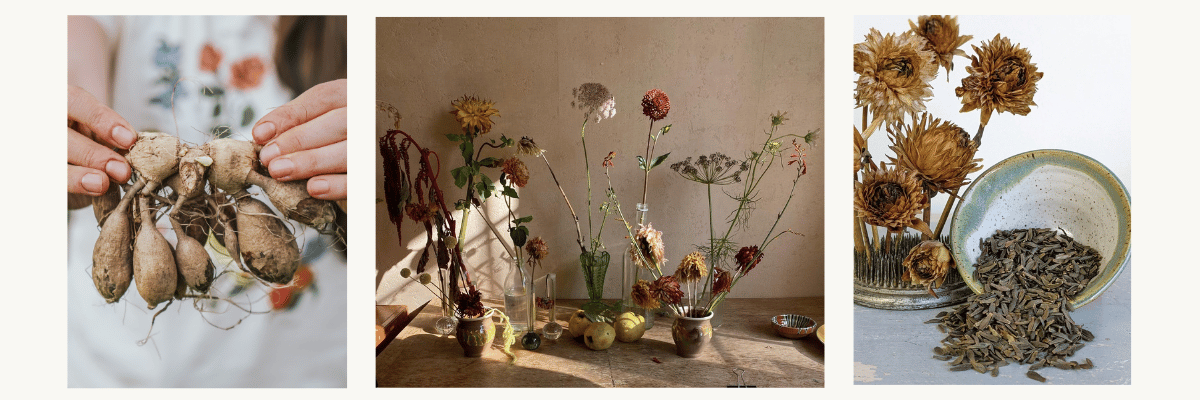Posted by Originally published by Sage Journal as part of the Autumn Gardening Series.
15th Apr 2025
A dahlia grower’s autumn checklist | How to prolong dahlia flowers & prep tubers for next season

Everything you need to know to prolong your dahlia flowers and prep your tubers for next season
Flowers are so fleeting. They’re such a good reminder to us to live in the present moment. And everyone’s (well, lots of peoples’!) favourite flower, the dahlia, is the perfect reminder of this in autumn at the end of the growing season.
Dahlias are beautiful flowers and long-lasting cut flowers — a must have in your garden beds. These late summer showstoppers take so many months of growing lush, leafy foliage with buds that seemingly take weeks to unfurl when they are young plants in your early summer garden. Finally, by the time we are blessed with abundant blooms, the risk of frost is threatening to end it all for us too soon. But before you start rushing out into the garden to call it a day on their showy blooms, there is still plenty more time left in the season to extend your harvests and prep for next season (as long as the frost-fairy stays away!).
In this article, you’ll find out what tasks you should be doing in early, mid and late autumn in the dahlia patch.
Frost & flowers
Dahlias are frost tender perennials. Meaning they will be damaged by a heavy frost, where their foliage will blacken and die back to the underground tuber.
In New Zealand, the warmer climates (areas north of Christchurch) should remain frost-free throughout March and into April. By late April you may have experienced one or two light frosts, depending on your location.
For south of Christchurch, your summer season is typically shorter and, unfortunately, you may experience your first frost as early as the beginning of autumn. So, it pays to be vigilant and have your dahlias prepared for this (more on this below).
Early autumn: Keeping dahlias blooming
Extend your harvest
If you’re north of Christchurch, you’re in luck — there’s still time to enjoy bucket loads of dahlias! Keep deadheading spent flower heads, and your plants will continue their flower production. When cutting, go deep into the plant to prevent it from becoming top-heavy.
Prevent disease
As temperatures cool, pests and diseases become more active. Powdery mildew is a common issue for dahlias, but you can minimise its spread by removing lower leaves to for good air circulation and improve airflow. If powdery mildew appears on upper leaves, treat it quickly with a homemade milk tea spray.
Watch for pests
Katydids, caterpillars and earwigs love dahlias — and not in a good way! It’s a good idea to clear away dead plant material to avoid attracting these unwanted visitors. Think of it this way: a tidy garden means fewer pests looking for an easy meal.
Fertilising for continued blooms
If frost isn’t a concern in your area, you can give your dahlias one last feeding to encourage flowering into the winter months. Choose a phosphorus and potassium-rich fertiliser to support strong stems and blooms — avoid nitrogen-heavy fertilisers, as too much nitrogen can weaken tubers. A sprinkle of natural potash at the base of the plants before mulching works wonders for those floppy late-season blooms.
Mid autumn: Prepping for the seasonal shift
Reduce plant stress
With warm days and cool nights, your dahlias plants will appreciate a little extra care. Start a fortnightly seaweed application — either as a soil drench to get beneath the soil surface or foliage spray — to give them a natural resilience boost.
Mulch for protection
A layer of compost mulch not only insulates the soil on chilly nights but also helps the soil retain moisture during warmer autumn days. If you lift your tubers later, this mulch will mix nicely into the soil when the time comes.
Label before it’s too late
The danger of frost is just around the corner, so autumn is the best time to label your plants! Whether you use tags or flagging tape, having clear labels will be invaluable when lifting and storing tubers.
Save dahlia seeds for a surprise
Growing dahlia plants from seed is an exciting experiment, since they never grow back exactly the same as their parent plant. If you want to try breeding your own varieties of dahlias, allow some flowers to go to seed. Ideally, wait until the seed heads turn brown before harvesting, but if rain or frost threatens, pick them early and dry them indoors in a glass of water until they’re crisp.
Late autumn: Wrapping up the season
Cut back after frost
Once the first hard frost hits, your dahlia foliage will turn black. This is your cue to cut it back and compost the remains. If you don’t get hard frosts, mimic the process by trimming plants to about 20cm above the ground. If you’re leaving the tubers in the soil, mulch heavily around the base of the plants to protect the tuberous roots. If lifting, wait about two weeks to let the tubers harden before storage.
Lifting & cleaning tubers
Carefully dig around each clump, leaving a 10cm margin to avoid damaging the tubers. If your soil is heavy or wet, lift gently and use your hands if needed. Shake off excess soil or rinse lightly to check for disease, though leaving a bit of soil can help prevent drying out. Let them dry in a sunny location for a day or two before brushing off any remaining dirt.
Check for crown gall
While handling tubers, inspect for crown gall — a bacterial infection that appears as white, cauliflower-like growths on the crown or neck. If you spot it, the best thing is to discard affected tubers immediately — do not compost them.
Proper storage for healthy tubers
Store tubers in a frost-free, dry area. The best way to store dahlia tubers is in crates or cardboard boxes to allow good air circulation — airtight containers can trap moisture and cause rot. Keep them off concrete to prevent moisture loss, placing them on a shelf or table instead.
Monitor throughout the season
Check tubers regularly. If they start shrivelling, add damp potting mix. If mould appears, mix in vermiculite to absorb excess moisture. A little attention now ensures strong, healthy plants next spring!
—
As autumn settles in, tending to your dahlias at the end of the season will set you up for success next season. Whether you're trying to extend their bloom cycle, preparing to store tubers or saving seeds, these simple steps ensure strong, healthy growth for your dahlias plants for next spring. A little effort now means you'll be rewarded with another season of abundant blooms — ready to steal the show all over again.
________________________________________________


























